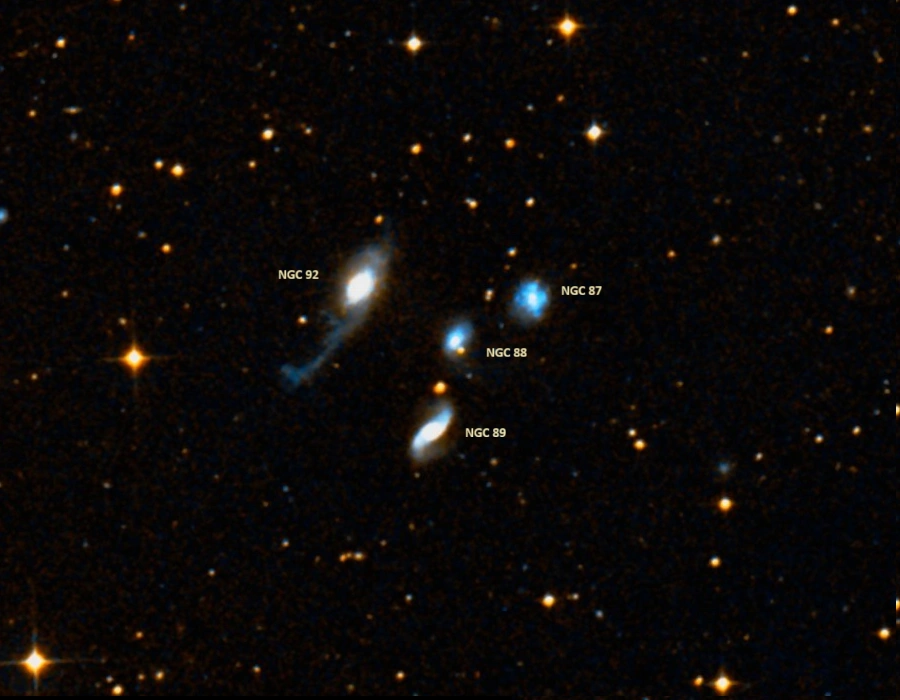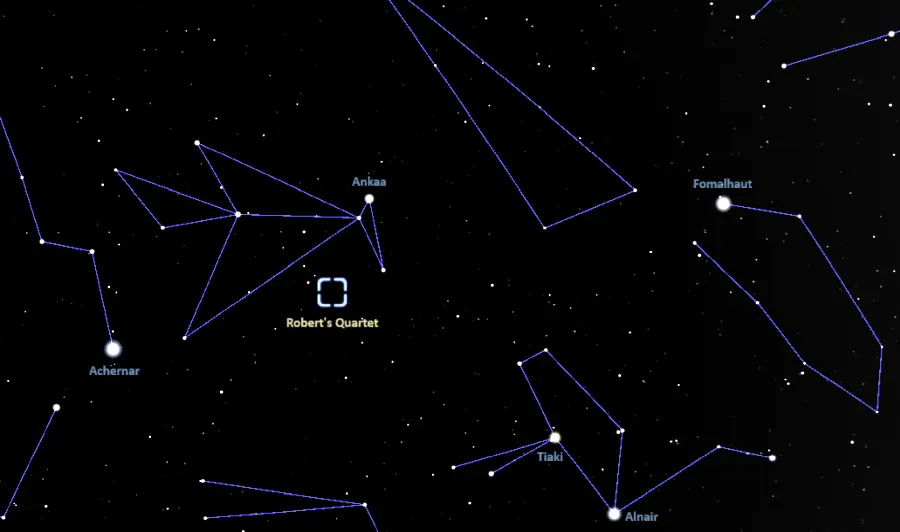Robert’s Quartet is a compact group of four galaxies located in the southern constellation Phoenix. The galaxies – NGC 87, NGC 88, NGC 89, and NGC 92 – lie approximately 160 million light years away. They have a total apparent visual magnitude of almost 13. With an angular size of only 1.6 arcminutes, they are a very difficult target for amateur telescopes.
The compact galaxy group is also known as the Phoenix Group. It is catalogued as AM 0018-485 in Halton Arp and Barry F. Madore’s A Catalogue of Southern Peculiar Galaxies and Associations (1987). Arp and Madore named the group Robert’s Quartet after Robert Freedman, who revised the coordinates of many of the peculiar galaxies included in the catalogue.
Robert’s Quartet is one of the best-known compact galaxy groups in the sky, along with Stephan’s Quintet and the NGC 7331 Group in the constellation Pegasus, Seyfert’s Sextet in Serpens, Copeland’s Septet in Leo, Zwicky’s Triplet in Hercules, and Wild’s Triplet in Virgo.

Robert’s Quartet is a family of four very different galaxies, located at a distance of about 160 million light-years, close to the centre of the southern constellation of the Phoenix. Its members are NGC 87, NGC 88, NGC 89 and NGC 92, discovered by John Herschel in the 1830s.NGC 87 (upper right) is an irregular galaxy similar to the satellites of our Milky Way, the Magellanic Clouds. NGC 88 (centre) is a spiral galaxy with an external diffuse envelope, most probably composed of gas. NGC 89 (lower middle) is another spiral galaxy with two large spiral arms. The largest member of the system, NGC 92 (left), is a spiral Sa galaxy with an unusual appearance. One of its arms, about 100,000 light-years long, has been distorted by interactions and contains a large quantity of dust. Image credit: ESO (CC BY 4.0)
The tight grouping of galaxies spans an area only 150,000 light-years across. It consists of four very different galaxies, listed as NGC 87, NGC 88, NGC 89, and NGC 92 in the New General Catalogue.
The galaxies of Robert’s Quartet are affected by gravitational forces as a result of their mutual interaction. They have a common envelope of H I gas and there is a tidal bridge connecting NGC 92 and NGC 88. NGC 92, the most prominent member of the group, has an extended gaseous tidal tail that hosts young star forming regions.
The stellar bridge between NGC 92 and NGC 88 indicates that the two galaxies have interacted in the past. The close encounter may have contributed to a central gas inflow towards NGC 92, which in turn triggered a starburst in the galaxy’s centre. NGC 88, on the other hand, may have lost its neutral hydrogen gas as a result of the interaction.
Observations with the FORS2 instrument on the Very Large Telescope (VLT) have helped astronomers identify more than 200 active star forming regions in the group’s largest member, NGC 92. These H II regions are 500 to 1,500 light-years across. The smaller NGC 87 contains 56 regions of active star formation, while the other two galaxies contain fewer such regions.
Robert’s Quartet was discovered by the British astronomer John Herschel using a 20-foot reflector at his Feldhausen Observatory in Cape Town, South Africa, on September 30, 1834. Herschel catalogued the objects as h 2316 (NGC 87), h 2317 (NGC 88), h 2318 (NGC 89), and h 2319 (NGC 92). He later listed them as GC 43, GC 44, GC 45, and GC 56 in his General Catalogue of Nebulae and Clusters of Stars (GC) of 1864.
Danish astronomer John Louis Emil Dreyer included the objects as NGC 87, NGC 88, NGC 89, and NGC 92 in his New General Catalogue (1888) based on Herschel’s observations.

Robert’s Quartet galaxies, image credit: ESO/Digitized Sky Survey 2 (CC BY 4.0)
NGC 87
NGC 87 is a barred irregular galaxy similar to the Magellanic Clouds, located approximately 154.7 million light-years away. It has an apparent magnitude of 14.1 and an apparent size of only 0.9 by 0.7 arcminutes, corresponding to a physical size of around 51,500 light-years.
The diffuse galaxy hosted a supernova observed in 1994. The supernova, SN 1994Z, was classified as a type II supernova and shone at magnitude 14.6. It was discovered by Alexander Wassilieff from New Zealand on October 2, 1994. The supernova occurred about 36 arcseconds east and 12 arcseconds south of the galactic centre of NGC 87.
NGC 88
NGC 88 is the central galaxy of Robert’s Quartet. It is a barred spiral galaxy located 160 million light years away. It has an apparent magnitude of 14.1 and an apparent size of 0.8 by 0.5 arcminutes. The galaxy is notable for its inner ring structure and diffuse envelope of gas.
NGC 88 hosted an optical transient, a supernova candidate designated ASASSN-15ut, in 2015. The transient was discovered during the All Sky Automated Survey for SuperNovae (ASAS-SN) with the Cassius telescope in Cerro Tololo in Chile. It was located 5.7 arcseconds south and 10.2 arcseconds west of the galaxy’s centre. It shone at magnitude 17.88.
NGC 89
NGC 89 is a barred spiral or lenticular galaxy located at a distance of 144 million light years. It has an apparent visual magnitude of 14.18 and an angular size of 0.957 by 0.459 arcminutes.
NGC 89 is classified as a Seyfert 2 galaxy. It has an active galactic nucleus and a jet that extends around 4 kiloparsecs to the northeast. The galaxy contains a ring that shows enhanced star formation.
NGC 92
NGC 92 is an unbarred spiral galaxy located approximately 141 million light-years away. It is the brightest and largest of the four galaxies in Robert’s Quartet. It has an apparent visual magnitude of 13.81 and an angular size of 1.9 by 0.9 minutes of arc. One of its spiral arms is around 100,000 light-years long. The arm has been twisted out of shape by interactions with the galaxy’s neighbours. It contains large amounts of dust.
The galaxy has an extended tidal tail with numerous star-forming regions. The young open clusters that formed in these complexes have estimated ages of less than 8 million years. The tail itself has an age of around 190 million years.

Using this H-alpha image of NGC 92 obtained with FORS2 on the VLT, astronomers were able to study the properties of regions of active star formation (“HII regions”). They found more than 200 of such regions in NGC 92, with a size between 500 and 1,500 light-years. Credit: ESO (CC BY 4.0)
Location
Robert’s Quartet lies in the far southern sky, near the centre of the relatively inconspicuous constellation of Phoenix. The galaxy group appears about a third of the way from Achernar in Eridanus to Fomalhaut in Piscis Austrinus.
At declination −48° 38′, the four galaxies are best seen from the southern hemisphere. They never rise above the horizon for observers south of the latitude 41° N.

Robert’s Quartet location, image: Stellarium
Robert’s Quartet
| Constellation | Phoenix |
| Object type | Compact galaxy group |
| Right ascension | 00h 21m 23.075s |
| Declination | −48° 37.75′ 39.5 |
| Apparent magnitude | ~13 |
| Apparent size (radius) | 1.6′ |
| Distance | 160 million light years (49 megaparsecs) |
| Redshift | 0.011275 |
| Heliocentric radial velocity | 3361 km/s |
| Size | 150,000 light-years (45,990 parsecs) |
| Names and designations | Robert’s Quartet, Phoenix Group, Arp-Madore 0018-485, AM 0018-485, SCG2 0018-4854, [R77] 34 |
NGC 87
| Object type | Barred irregular galaxy |
| Morphological type | IBm pec |
| Right ascension | 00h 21m 14.2133s |
| Declination | −48° 37′ 42.81″ |
| Apparent magnitude | 14.1 |
| Apparent size | 0.9′ × 0.7′ |
| Distance | 154.7 ± 11.0 million light-years (47.44 ± 3.36 megaparsecs) |
| Redshift | 0.011391 |
| Heliocentric radial velocity | 3415 ± 23 km/s |
| Size | ~51,500 light-years (15.80 kiloparsecs) |
| Names and designations | NGC 87, LEDA 1357, PGC 1357, ESO 194-8, ESO 194-G008, ESO-LV 194-0080, 2MASX J00211406-4837482, APMBGC 194+100-062, dFGS gJ002114.2-483743, SGC 001848-4854.4, [BMB96] 1d |
NGC 88
| Object type | Barred spiral galaxy |
| Morphological type | SB(rs)a pec |
| Right ascension | 00h 21m 22.0352346168s |
| Declination | −48° 38′ 24.141829488″ |
| Apparent magnitude | 14.1 |
| Apparent size | 0.8′ × 0.5′ |
| Distance | 160 million light years (49 Mpc) |
| Redshift | 0.011615 ± 0.000287 |
| Heliocentric radial velocity | 3462 ± 86 km/s |
| Names and designations | NGC 88, LEDA 1370, PGC 1370, ESO 194-G010 |
NGC 89
| Object type | Barred spiral or lenticular galaxy |
| Morphological type | SB0/a pec |
| Right ascension | 00h 21m 24.355s |
| Declination | −48° 39′ 55.28″ |
| Apparent magnitude | 14.18 |
| Apparent size | 0′.957 × 0′.459 |
| Distance | 144 ± 10 Mly (44.1 ± 3.1 Mpc) |
| Redshift | 0.012838 ± 0.000143 |
| Heliocentric radial velocity | 3824 ± 43 km/s |
| Names and designations | NGC 89, LEDA 1374, PGC 1374, ESO 194-11, ESO 194-G011, ESO-LV 194-0110, 2MASX J00212435-4839552, APMBGC 194+099-060, 6dFGS gJ002124.4-483955, SGC 001857-4856.6, [BMB96] 1b |
NGC 92
| Object type | Unbarred spiral galaxy |
| Morphological type | SAa: pec |
| Right ascension | 00h 21m 31.713s |
| Declination | −48° 37′ 29.23″ |
| Apparent magnitude | 13.81 |
| Apparent size | 1.9′ × 0.9′ |
| Distance | 141 Mly (43.2 Mpc) |
| Redshift | 0.011278 ± 0.000037 |
| Heliocentric radial velocity | 3362 ± 11 km/s |
| Names and designations | NGC 92, LEDA 1388, PGC 1388, ESO 194-12, ESO 194-G012, ESO-LV 194-0120, 2MASX J00213171-4837292, APMBGC 194+098-062, 6dFGS gJ002131.7-483729, SGC 001905-4854.2, [BMB96] 1a |